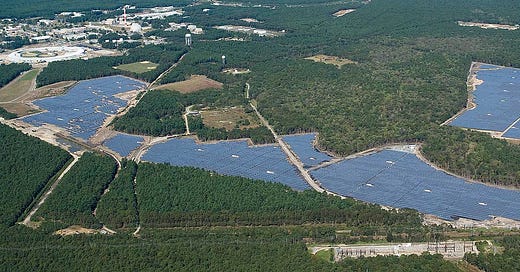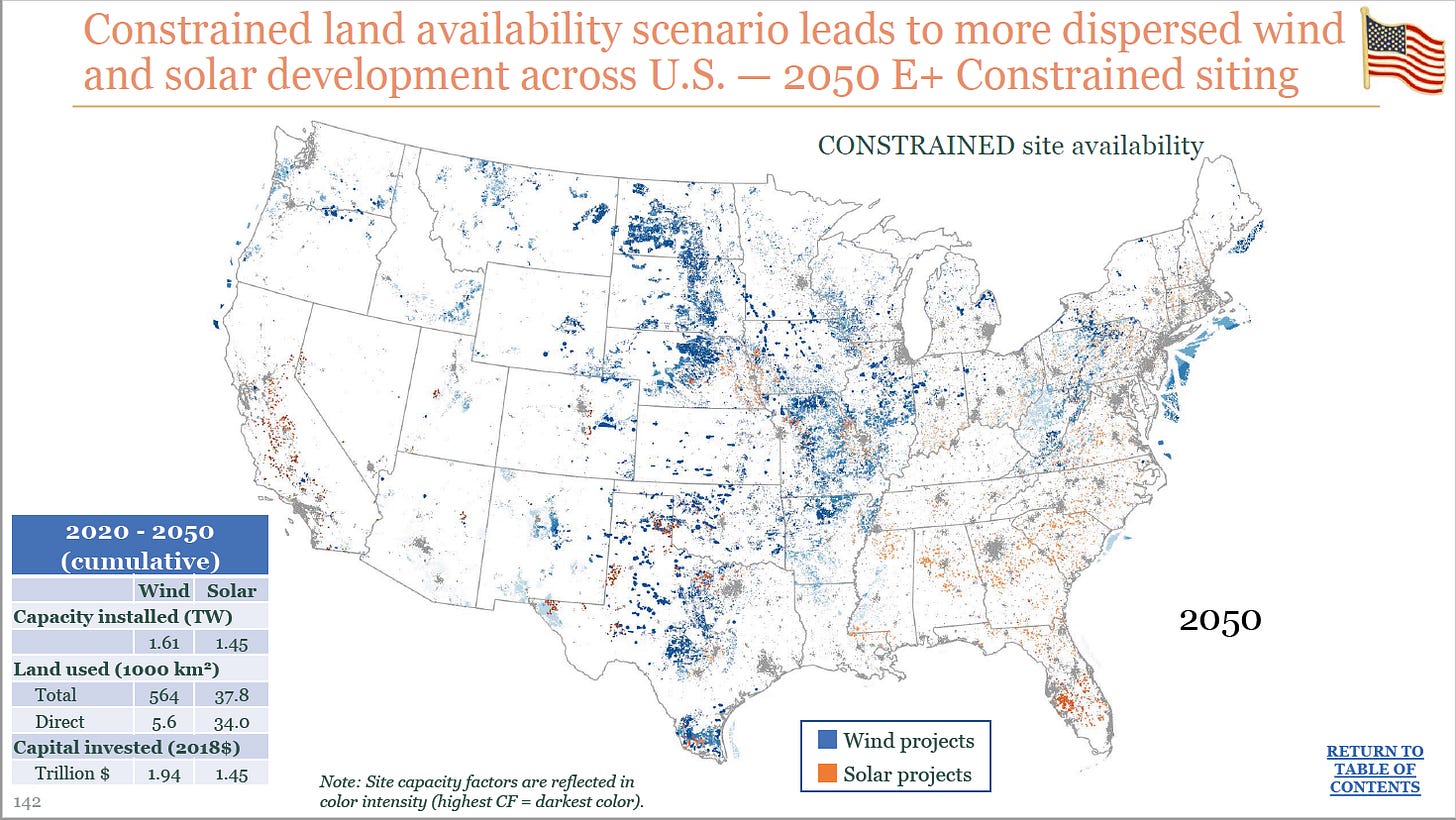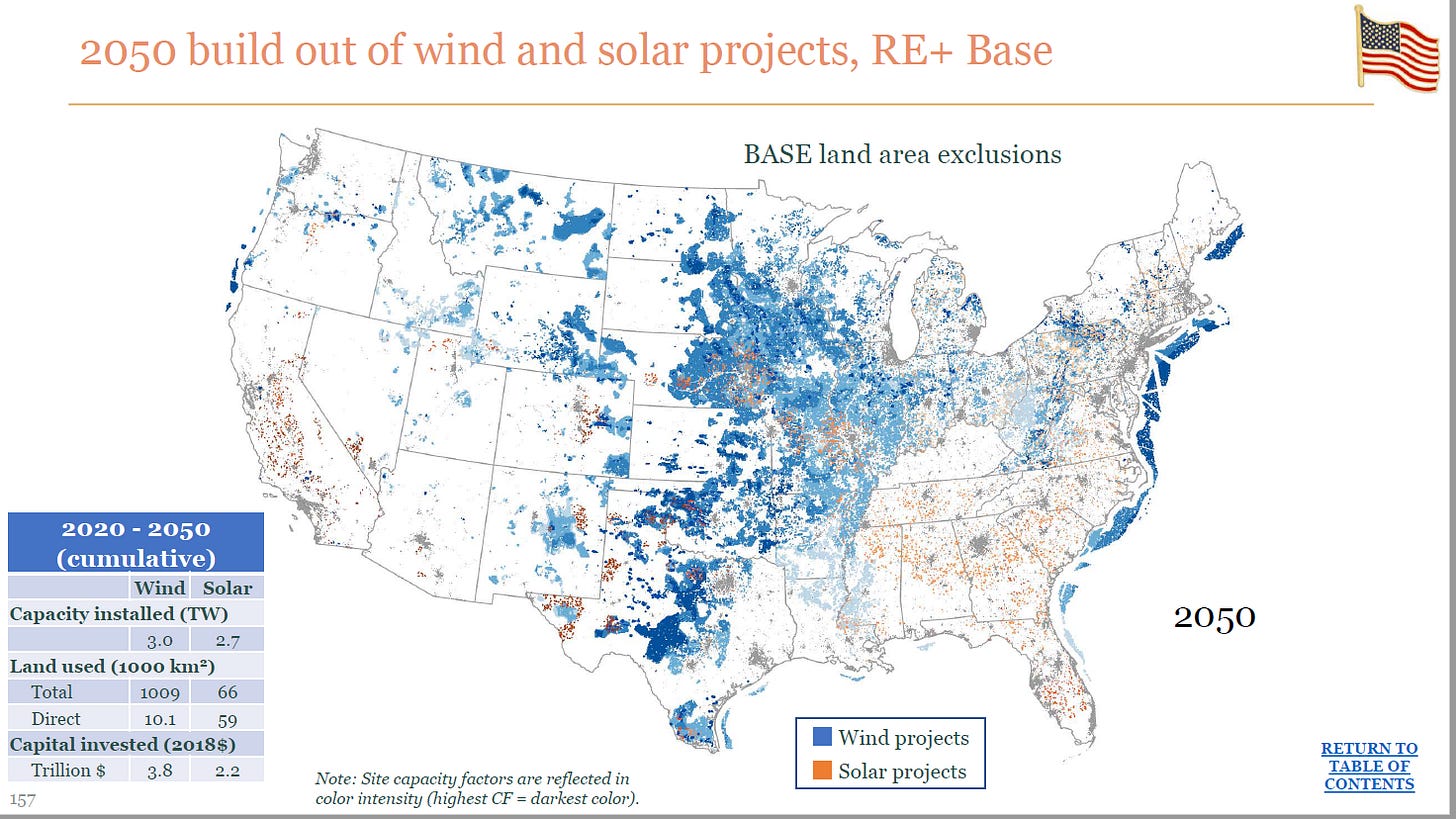Land Use Will Limit Growth of Renewable Energy
One of the most prominent claims made by the environmental left is that we can run the world, or at least the electrical grid, on 100% renewable energy and completely eliminate hydrocarbons. These engineering claims don't hold up though because their renewable electricity-first model does not work for heavy industry and the military.
More importantly, land-use limitations will severely cramp the development of industrial solar and wind long before the electricity production targets are hit. Climate activists routinely overstate the productivity of wind and solar and understate the negative impacts on the landscape. We need ecosystem networks intact to serve as critical carbon sinks in order to hit net-zero carbon targets.
32 MW at Brookhaven National Lab, Long Island NY (photo by BNL)
Hydropower is by far the most cost-effective, productive, and reliable form of renewable energy, but we are not building any new dams in North America because all the good sites have already been built. There is no room for significant expansion of hydropower without unacceptable environmental impacts. Industrial wind and solar will face the same plateau once the best sites are saturated.
To meet the climate activist goals of completely eliminating coal, oil, and natural gas, we need a massive expansion of wind and solar technologies at scales that are difficult to imagine. Let’s take a look at what the big industrial solar projects look like.
Net-Zero America Project
The Net-Zero America Project: Finding Pathways to a Carbon-Neutral Future from Princeton University details realistic engineering scenarios for how to achieve net-zero carbon emissions.
This study does an excellent job of mapping the land use from industrial wind and solar, including electrical transmission lines. I commend the authors, Eric Larson, Chris Greig, and Jesse Jenkins for their rigorous analytic process and honest scholarship. The report is an outstanding piece of work.
In my opinion, this study demonstrates exactly why activist projections for wind and solar are completely unachievable.
https://acee.princeton.edu/rapidswitch/projects/net-zero-america-project/
The following maps and graphics from the Princeton study do an excellent job of detailing the immense scope required to develop industrial wind and solar to the point that it rivals fossil fuels. We would have to cover thousands of square miles in wind turbines and solar panels. The base case shows 38,000 sq km (23,612 sq miles) dedicated to industrial solar alone, a landmass equivalent to the size of West Virginia. Wind farms would cover the equivalent of six mid-western states. The high penetration case doubles the amount of land use.
These maps show how industrial wind and solar would be visible from space, displacing massive amounts of ecosystems and habitat. The entire eastern USA used to be a thick, old-growth forest, and those trees could return if we cultivated them. But 100% renewable energy would ravage the landscape.
Low penetration wind and solar
High penetration wind and solar
These charts show area details. Each of those big orange blocks is a ~500 MW solar farm covering ten square miles.
Solar Case Studies
Here are examples of industrial solar projects that represent the genuine challenges facing this massive expansion of renewable energy. The biggest problem is that neighbors despise these projects because they decimate the landscape and ecology. We are looking at solar here but the same issue exists for industrial wind power. I will address the significant downsides of industrial wind in another article.
The New York Times on community resistance to industrial solar around the country.
https://www.nytimes.com/2020/03/18/nyregion/solar-energy-farms-ny.html
Virtually every large project like these face similar resistance from local landowners and community members. Zoning fights are now routine and several states have issued moratoriums against industrial solar.
Spotsylvania, VA
This 500 MW, 10 sq mile solar farm in Spotsylvania, VA would be one of the largest solar projects in the USA and the biggest in the east. The project is currently under construction though it is strongly protested by neighbors who object to such a large project and consider it wildly out of scale with the landscape.
https://spotsylvania-solar.spower.com/
Site A - 400 MW = 5200 acres = 8.125 sq miles
Site B - 70 MW = 905 acres = 1.4 sq miles
Site C - 30 MW = 245 acres = .38 sq miles
Total - 500 MW = 6350 acres = 9.9 sq miles
(640 acres = 1 sq mile)
https://sites.google.com/view/concernedcitizensspotsylvania/home
Rush, NY
The Horseshoe Solar project is currently being developed in upstate NY. It is 180 MW spread across 1500 acres, or 2.3 sq miles. This project is being actively resisted by community members.
https://horseshoesolar.invenergy.com/
https://13wham.com/news/local/solar-project-reaches-milestone
Gov. Cuomo wants to fast track industrial solar in New York. Here are pictures I took of some upstate NY solar farms in the winter. They are not making any electricity at all, covered in snow under months of grey skies. Their capacity factor is in the low teens, they are turned off more than 85% of the time over the year. Meanwhile, the land has lost its value as a functioning ecosystem. We are supposed to build hundreds of these projects across New York state? Dozens of 500 MW projects covering 10 square miles apiece? Really?
An Alternative Vision
I want to be abundantly clear that I am pro-wind and solar power. I make my living developing commercial solar projects, mostly large warehouse rooftops. We need to sell a zillion solar panels between now and net-zero, and I am more than happy to do my part, it is putting my kids through college. But these big industrial solar farms are not good land use and not good policy. On the path to net-zero, it is more important that we restore ecosystems and create carbon sinks rather than tear up Mother Nature to install tomorrow’s electronics waste.
The projections presented in the Princeton study demonstrate the massive impact on our landscapes that are required for wind and solar to achieve anything close to 100% renewable energy. Considering the fervent community resistance that every single industrial wind and solar project faces, it strains credulity to believe that anything close to these projections will actually get built. 100% renewable energy would require thousands of solar farms in the 500 MW range across the country, each covering ten square miles of land.
Solar power is best developed on rooftops and degraded lands. Good candidates for solar farms include contaminated brownfield sites, landfills, urban vacant lots, and select fields that are advantageously located near grid transmission points. These are the locations we should be maximizing for solar power, but let's not cut down healthy forests and intact ecosystems. These lands are more valuable to us for their ecosystem services that provide carbon sequestration, freshwater restoration, and wildlife habitat.
Fortunately, alternatives to 100% renewable energy exist that will still get us to net-zero carbon emissions by 2050. It starts with putting nature first, ahead of human techno-utopianism. Restoring forests and ecosystems will directly cool the planet by providing shade and rain. Regenerative agriculture and growing plants sequester carbon in soils. Carbon sequestration counts scale logarithmically as ecosystems mature and become stocked with wildlife.
Preserving our natural gas infrastructure enables us to leave all the coal and petroleum in the ground without sacrificing heavy-duty and high-performance machinery. We can upgrade our military by converting to cleaner, synthetic fuels produced from methane and carbon dioxide.
Methane is non-toxic, wildly abundant, renewable, and is a universal fuel that covers all sectors of industry; heat, power, and transportation. A hybrid gas-electric model is scalable from small micro-grids to vast cityscapes and battleships. The hybrid model is reliable, cost-effective, and redundant – features that are lost in electric-only models.
The use of natural gas also facilitates industrial carbon capture. Next-generation Allam-cycle power plants have now moved beyond the demonstration phase and are going into commercial production. Allam-cycle power plants have integrated carbon capture, there is no smoke-stack at all, the only exhaust from the plant is a pipeline of water and a pipeline of CO2. Allam-cycle power plants are a game-changer that will allow carbon capture to become a cost-effective standard feature on all new power plants that can be located near a CO2 pipeline.
Industrial CO2 is currently being injected into saline aquifers and old oil wells for disposal. This is ok at the moment, but a better solution will be to take the CO2 offshore and inject it into the hydrate formations under the deep sea-floor where the CO2 will be locked into ice for thousands of years. These hydrate formations contain thousands of years of supply of pure methane. The CO2 can be injected while the methane is harvested, providing an elegant zero-waste solution for our natural gas needs. Methane is also renewable in large volumes and should properly be considered a living fuel rather than a fossil fuel since it is literally a building block of life.
A hybrid gas-electric model that balances the use of renewable energy with natural gas offers a reliable, cost-effective, and robust engineering solution that satisfies all the needs of industry and the military. Electrification of light-duty transportation and space heating will slash aggregate CO2 emissions. Net-zero carbon emissions can be achieved through a combination of industrial carbon capture and a committed effort to restore ecosystems to full vitality.













